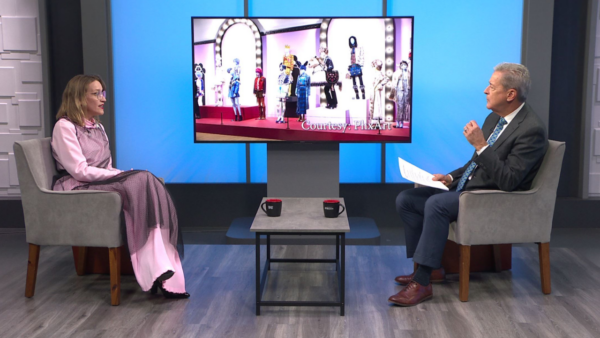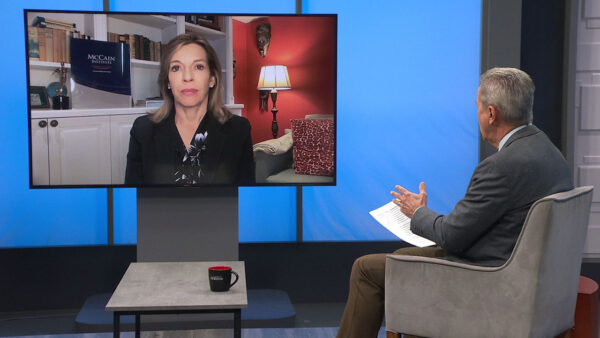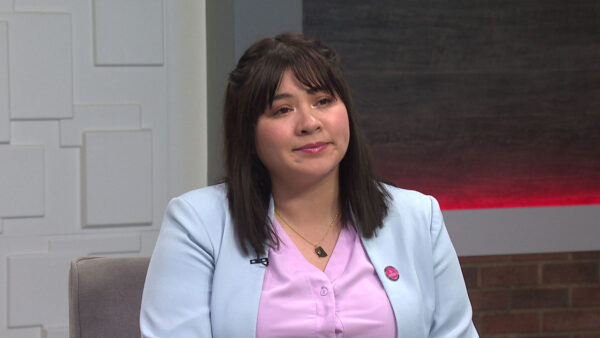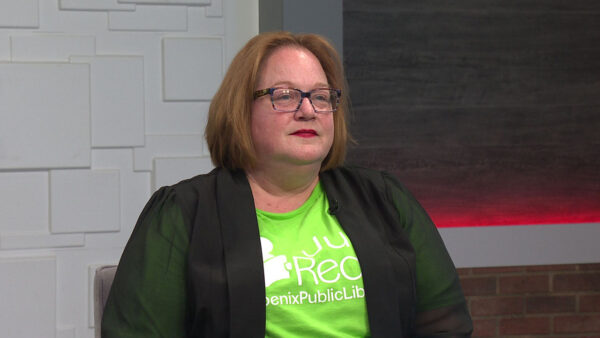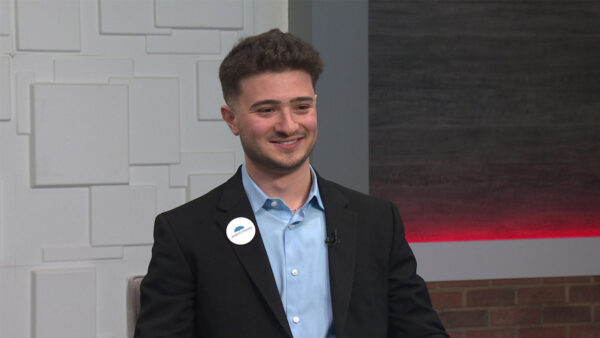Federal stimulus dollars are providing a huge financial lift to a program that helps low income Arizonans save money on their utility bills while making their homes more energy efficient. We’ll take a look at this program that saves energy, lowers utility bills, makes homes safer, and keeps people employed.
Ted Simons: Good evening, and welcome to "Horizon," I'm Ted Simons. The Phoenix Convention Center is awash in green this week as thousands take part in green build, the world's largest conference dedicated to sustainable building. Tonight we continue our series on building green by taking a look at a federal program that helps low-income people by making their homes more energy efficient.
David Majure: High energy bills are a pain for a lot of people, but they are a problem for those who simply can't afford them.
Shirley Hernandez: Last year my highest bill was $829.
David Majure: During the summer Shirley Hernandez was paying an average of $300 to $400 a month for electricity. That's a fortune for a single mom on fixed disability income of almost $1800 a month with a mortgage payment of $1000.
Shirley Hernandez: It was either pay my house payment or electric bill. I'm a payment behind on my house, it was too hot.
David Majure: Technicians from the Foundation for Senior Living are trying to make Shirley more comfortable and save her some money. They recently did an energy audit on her house looking for ways to make it more energy efficient. Using the latest technology they measure how airtight the house is. Then they track down leaks that make air conditioners work harder.
Charlie Gohman: Watch the air just go right out the door.
David Majure: It's part of the U.S. Department of Energy's weatherization assistance program. In Arizona, it's administered by the state department of commerce.
Charlie Gohman: A large percentage of the clients are either elderly, on fixed income, disabled. But now we're seeing more of people that are unemployed, you know, losing their jobs. Historically it's been elderly, disabled people on fixed income. An average person might pay 5%, 6% of their income on utility costs. Low-income people are perhaps paying 20%, 25%.
David Majure: The program's been helping low-income Arizonans for decades. Over the next three years the Federal Stimulus Plan will pump $57 million into this program that had been operating on less than $5 million a year.
Charlie Gohman: We are expanding the amount of work that we can do, probably by a factor of 10.
David Majure: That means going from 800 homes a year to 8,000 or more in the next three years. All of that work requires many more workers.
Charlie Gohman: So that's the biggest thing, just that we have to go out and ramp up so we're doing an awful lot of training.
Worker: What this really means --
David Majure: The training takes place at the foundation for senior living's training center in Phoenix. In the past it trained about five people every two months. Now it's training more than 30 a month, putting a lot of construction workers back to work doing home energy audits.
Charlie Gohman: That's what the stimulus is really doing. We're training a lot of people, putting people to work in a really important industry.
David Majure: Back at Shirley's house the technicians have identified a number of problems, including leaky air ducts and an air conditioner that needs replacing.
Vinny Pedalino: We anticipate phenomenal savings in this house. Even though we'll probably do more, those are the big things. Duct Leakage is the number one cost-effective thing we can do in homes.
David Majure: The weatherization program will pay for the repairs as long as they are cost-effective.
Charlie Gohman: The common things we do are duct sealing, air sealing, sealing up the holes between the house and the outside. Insulating the attic, shade screens on windows. We do an awful lot of replacing of equipment.
David Majure: On average, for every dollar spent the program generates $1.30 in savings. Shirley should see a difference in her utility bill when the work is done.
Vinny Pedalino: It's hard to make predictions, but I'm pretty confident we can cut her bill in half, if not a lot more than that.
Shirley Hernandez: I'm blessed. I won't lose my house. Thank God, I didn't know what I was going to do. Thank God they were able to help me.
Ted Simons: Joining me to talk about the weatherization program is Mary Lou Rosales, the executive director of the community action resources agency in Pinal County, and Charlie Gohman, manager of the design provision at the energy office. Charlie, we saw you there at Shirley's house. She's expecting to see quite a difference in her utility bills. Is she seeing them?
Charlie Gohman: Like they said, last year she had over $800 in one month. This year the high bill in the hottest part of the summer was $350.
Ted Simons: Is that typical of the kind of thing you're seeing out there once you get to these homes and start to work on them?
Charlie Gohman: Her highest summer bills were extremely high. On average we're saving about $300 per year in the work we do.
Ted Simons: Is that what you're seeing, as well?
Mary Lou Rosales: We are, and we're saving a lot of -- receiving a lot of thank-you notes and letters of appreciation. It's wonderful.
Ted Simons: On average, give us some other stories down there besides Shirley's.
Mary Lou Rosales: In our area an example is -- a lot of times people need help, and they don't know that it's weatherization. So what they do is come to us as a community action agency to ask for help. An elderly couple whose bills were so high did not know what to do, they applied through our agency and they are very, very grateful.
Ted Simons: Who qualifies for this program?
Charlie Gohman: It's based on income. 200% of the poverty level, and that is based on the number of people in your home. It varies depending on family size. It's 200% of the federal poverty guidelines.
Ted Simons: Has that changed over the years?
Charlie Gohman: Yes. It was 150 in previous years, but with the stimulus money they increased it to 200%.
Ted Simons: Will that fluctuate as far as conditions warrant?
Charlie Gohman: At this point I think they will keep it at that level for the foreseeable future.
Ted Simons: When we first saw Shirley's story in the summer, we had folks calling in and saying, what about renters? Can they take advantage of this?
Mary Lou Rosales: Yes, they can take advantage of this program. We have to work with their landlords and we have to have their approval. Yes, there has to be an investment, also, in the landlord's side.
Ted Simons: They can, but they have to get the permission of the landlords first?
Mary Lou Rosales: And those qualify, the 200% as mentioned.
Ted Simons: The renters have to qualify?
Mary Lou Rosales: Yes.
Ted Simons: Are you seeing many renters?
Mary Lou Rosales: We are, we are. It used to be it was so difficult, but now we are adding special projects, and we have a special project with the housing authority. It's HUD loans that have homes, separate single-family homes. We are going to be weatherizing 26 homes as a special project, after they have made some investments on major repairs. With Pinal County we are doing that in Apache Junction. We have 15 units in Apache Junction. We are really excited that in Casa Grande we are going to be able to weatherize the domestic violence shelter and children's shelter against abuse.
Ted Simons: These are places that have been there, I'm sure, for a while. People know they need some help, and now you've finally got the money for the help.
Ted Simons: Yes.
Ted Simons: Charlie, how much stimulus money is coming in right now?
Charlie Gohman: Over a three-year period, the stimulus was $57 million.
Ted Simons: And impact, just in general terms, what is that doing for the program?
Charlie Gohman: Yeah, it's allowing us to ramp up greatly. Really, the big impact is a lot of the hiring we are able to do. For example, I've known this one inflation company that's done a lot of work in new construction. I've worked with them for years in other areas. They were ready to go out of business this spring. They are staying in business and rehiring people they were laying off because of the work they are able to get through this program.
Ted Simons: The stimulus money at its base is supposed to be a job stimulus program. Are you seeing a lot of that? Obviously the one company you mentioned, but are you seeing a lot of folks getting back to work? Overall, what are you seeing?
Charlie Gohman: For example, the City of Phoenix used to use primarily contractors, four, and now they are up to around 20 or so. There are a lot of homes to weatherize, which means a lot of bodies in attics doing the work. It's a lot of jobs.
Ted Simons: With this extra money now, is it more homes being weatherized? Is it homes being weatherized more? How does this work?
Mary Lou Rosales: We are able to spend $6500 maximum per home, the average throughout the state. It doesn't have to be exactly at the $6500. That's great, it used to be $2200 and it's going to allow us to, I think, do a few more homes. With our agency we are contracted to do 275 homes over three years. Our normal contract would require us to do 44.
Ted Simons: Interesting. Is there a base you have to hit, as far as the stimulus money is concerned? When you go into a house, is it as much as the house needs? Is there some sort of leveling here?
Charlie Gohman: We basically do those measures that are cost-effective, that return in savings over their life more money than it costs to install them. That's the basic program guideline. It has to be cost-effective. With the extra stimulus money we are doing a lot more renewable, solar water heating is something that we're really beginning to be able to do. We couldn't do that in the past because of the funding levels we had. Now we're doing solar water heating on a regular basis.
Ted Simons: That is encouraging to hear that something you couldn't do before, now the money's coming in, now solar projects are getting done. Is this every project? Can you do this on every project now?
Charlie Gohman: No, it has to be specific to the house. The house you have to basically take the water heater. There are some characteristics that we have to look at. That's going to be pretty dependent on the house itself. We look at a house, each house is different. That's how we do the analysis, based on the house gets what it needs to make it as efficient as we can.
Ted Simons: Are you seeing solar energy and these sorts of retrofits going on?
Mary Lou Rosales: We are proud to say we are doing our first solar project and it's going to be with the domestic violence shelters, the water heaters.
Ted Simons: Very good. The history of this program, I know it's been -- it may surprise some folks, but it's been around for a while. Tell us about the history of the program.
Charlie Gohman: It started in the energy crisis back in the late seventies. It started in the northeast, a heating project. And then it expanded throughout the state, throughout the nation shortly after that. Yes, it's been around for 30-plus years, yeah, very successful. The interesting part relating to the green build is that the weatherization program really was probably one of the most successful unintentional research programs the Department of Energy ever did. Because of what we've learned on how you make homes perform. A majority of the technologies they talk about at the green build, when they are talking retrofitting existing homes, were developed, implemented, refined through the weatherization program and 30 years of experience.
Ted Simons: Some of these homes have been a laboratory over the years and now you're seeing results of some of this labor.
Mary Lou Rosales: Yes.
Ted Simons: As far as the history, how long have you been aware of the program and involved in the program?
Mary Lou Rosales: Since 1983.
Ted Simons: Since that long?
Mary Lou Rosales: That's right.
Ted Simons: Have you seen a change over the years?
Mary Lou Rosales: Oh, yes, yes, becoming more technical. I think we feel better about what we're doing because we see some results and some way to assess the homes and what they need. And you know, why invest the funds into the home if it's not going to make a difference?
Ted Simons: Indeed. As far as the stimulus money is concerned, how long does it last?
Charlie Gohman: Going too last into 2012. We're probably going to see, with a lot of our agencies, the concern was the ability to spend the money. We have a number of them say they will spend the money out quicker than the deadline. It was a three-year program we had to spend the money out.
Ted Simons: As far as what happens when the stimulus money goes away, what happens?
Mary Lou Rosales: Well, as I said earlier, we will cry -- no. We're going to make all efforts to assure that the people that have been trained, the equipment that we've purchased, vehicles, that we're able to use them and continue. We will be advocating for funding. The utility companies have been wonderful in providing funding for the program. Arizona Public Service, Southwest Gas, Salt River program, public service, we will be looking at them, too.
Ted Simons: It changes the ball game once the money goes away.
Charlie Gohman: Right. Our greatest fear is that we go back to the levels that we were at, and then we have to let go of all the people that we trained. Hopefully with other programs coming in they are talking about keeping the funding level, if not as high as it is now, at least not going back to where it was. There's good potential that the utilities are going to be bringing in more funding and they are ramping up all of their program.
Ted Simons: Talking with you about Pinal County, but what are you seeing in northern Arizona and western Arizona? Weatherization projects going on there, as well, what are you seeing?
Charlie Gohman: Pretty much the same picture throughout the state. The funding is based on population. Everybody's funding pretty much went up the same amount. Actually Arizona is one of the states that's out ahead. We had a training facility ready to go, so we're kind of ahead of the game there. We're out the gate and getting homes done throughout the state already.
Ted Simons: Does it sound like Arizona is a little bit ahead of the curve on this business?
Charlie Gohman: That's what we understand. We're one of the few states that are actually getting homes started. There was a delay because of Davis-Bacon requirements on the federal level, they had to work through a bunch of issues and get wage determinations done. But we were ready to go months before the federal government was ready to go. So once all of those issues were done, we're out there spending money, weatherizing homes.
Ted Simons: The last time we talked about it on the air we had a pretty good response and people wanted to know more about it. Is there one place they can go to get information on the weatherization project? Where can they go?
Charlie Gohman: They could go to the Department of Commerce website, azcommerce.com. In the energy division under the weatherization program, in there you'll find a list of the 10 agencies you need to contact, depending on what county you live in. You need to contact the local agency. They do all of the application, intake, income verification.
Ted Simons: And again, look for the weatherization link and kind of take it from there. Next question: Must kind of make you feel good doing something like this.
Mary Lou Rosales: Absolutely. And as I mentioned earlier, how many letters of appreciation? More than ever, more than ever. I wish I had one to show it to you today.
Ted Simons: Good enough. We got some good information from you. Thank you so much for joining us tonight on "Horizon."
Mary Lou Rosales:Executive Director of the Community Action Resources Agency in Pinal County;Charlie Gohman:Manager of the Design Provision at the Energy Office;



















